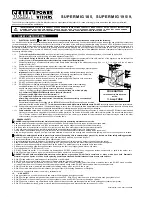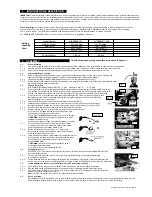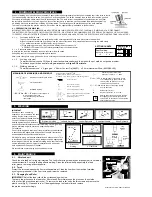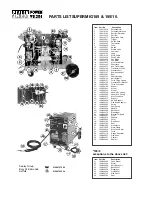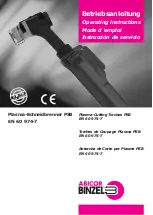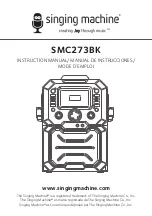
3. 1.
Wheel Assembly
3. 1. 1.
Turn machine upside down, and remove the screws attached to the bottom front, use these screws to attach the front castor wheels.
3. 1. 2.
Take the rear axle and fit a wheel to one end by placing a washer, then the wheel, a second washer and then insert a split pin.
3. 1. 3.
Pass the axle through the tube under the gas cylinder carrier, then fit the other washer, wheel, washer, split pin.
3. 2.
Connecting the gas cylinder
3. 2. 1.
When using Argon or Argon mixtures, you will need to use the Bull Nose Adaptor. If you intend to use CO2 gas, the
regulator will fit directly onto the cylinder. Fit the Bull Nose Adaptor to the cylinder with a spanner.
3. 2. 2.
Fit the gas regulator on the Bull Nose Adaptor and connect it to the machine gas hose (fig.1).
3. 2. 3.
Set the regulator flow rate to 5-8 litres/min depending on the material to be welded, and whether there are draughts which
are strong enough to disturb the gas flow.
3. 3.
Fitting a reel of wire
Wire capacity: (Mild Steel). Models: SM185 .....5 kilos, SM195/9, & 210/10, ...... 5 - 15 kilos.
3. 3. 1.
Push reel of wire over reel holder end springs and onto reel holder ensuring the spool rotates clockwise, with the
wire drawing off reel from the top (see white arrow in fig 2). Large spools of wire have a guide hole which must be
pushed onto plastic pin located at the end of the reel holder. This pin will stop larger reels from free wheeling.
3. 3. 2.
To secure the reel of wire take the plastic spacer and identify the two cut outs at one end (fig 2a). Place
the spacer over the holder end springs and onto the reel holder ensuring the two cut outs are facing
inward toward the reel of wire (fig. 2).
3. 3. 3.
Undo the wire lock screw and lift the wire feed lever up to the right (fig 2).
3. 3. 4.
Straighten about 40-50mm of spool wire (
do not allow wire to uncoil
), and gently push wire through
the plastic guide and through the 6 or 8mm roller groove (see 6.3), and through to the torch (fig. 3).
3. 3. 5.
Carefully return the tension arm and secure wire with the wire lock screw.
3. 3. 6.
Remove gas cup (fig 3.3.6.a) and contact tip (b) from end of torch as follows:
a) Take torch in left hand with the torch tip facing to the right.
b) Grasp gas cup firmly in your right hand.
c) Turn gas cup
clockwise only (c)
and pull cup out to the right.
p
WARNING!
do not turn gas cup anti-clockwise, as this will
damage the internal spring.
d) Unscrew the copper contact tip (
right hand thread
) to remove.
3. 3. 7.
Check welder is switched off 0, and that the earth clamp
is away from the torch tip. Connect the welder to the mains
power supply and set the voltage switch to one.
3. 3. 8.
Set the wire speed knob to position 5 or 6. Keeping the
torch cable as straight as possible and press the torch switch.
The wire will feed through the torch.
3. 3. 9.
When wire has fed through, switch welder off, unplug from mains.
a) Take torch in left hand and screw contact tip back into place.
b) Grasp gas cup in right hand, push onto torch head and
turn
clockwise only
.
p
WARNING!
do not turn gas cup anti-clockwise, as this
will damage the internal spring.
c) Cut wire so that it is just protruding the cup.
3. 4.
Setting wire tension.
IMPORTANT: You must set the correct tension, too little or too much tension will cause problematic wire feed
and result in poor welding.
3. 4. 1.
For 0.6mm wire in mild steel the wire lock screw must be tightened fully and undone approximately
two complete turns (fig 4).
3. 4. 2.
Tension between rollers is checked by slowing down the wire between your fingers. If top feed roller skids the
tension is correct. Use as low a tension as possible, too high a tension will disfigure wire and result in a blown fuse.
3. 5.
Clutch adjustment. Note:
It is essential that the clutch is adjusted correctly.
3. 5. 1.
Once the wire is fed through the torch, switch on the machine and set the wire speed to maximum.
3. 5. 2.
Depress torch switch and release quickly. If the spool overruns it indicates that the clutch is too loose.
3. 5. 3.
Tighten the clutch (located in the centre of the wire spool holder fig 2) with a screwdriver and test the machine
as above until the wire stops over running.
Note:
DO NOT over tighten the clutch as this will cause wire feed problems.
3. 6.
Euro Connection.
Your welder has a Euro Connection. Line up pins in the torch with the appropriate holes in the machine, push in and tighten knurled knob (fig. 5 A).
When welding is finished remove torch and store in a safe place.
Note: damage to torches and cables is not covered by warranty.
3. ASSEMBLY
To fit the mains power plug see safety instructions (Chapter 1.).
A
c
fig 1.
fig 2.
fig 2a.
fig 3.3.6.
fig 4
fig 3.
fig 5
These Supermigs
are compact power sources, that operate on a forced air cooling system to slow transformer heating in order to increase the duty cycle.
They also have a non live torch to prevent the risk of accidentally striking an arc. Your Supermig is designed to operate with two diameters of welding
wire: 0.6mm, & 0.8mm. The 185 will accommodate 5kgs wire spool, and the 195/9 will accommodate 5 to 15kgs wire spools.
ALL MODELS ARE EQUIPPED WITH:
3
Torch,
3
Mini reel of 0.6mm wire,
3
Regulator,
3
Gas hose.
2. INTRODUCTION & DESCRIPTION
Model Number
SUPERMIG 185
SUPERMIG 195/9
Welding Current
30-185 Amps
30-195 Amps
Duty Cycle
100% @ 60A
100% @ 60A
60% @ 80A
60% @ 80A
20% @ 140A
20% @ 140A
10% @ 160A
10% @ 165A
Power efficiency
5.9 Kva
6.0 Kva
Welding
Capability
Chart:
Supermig185, 195/9, 0051 (2) 180900
IMPORTANT:
These instructions contain information you require to prepare your machine for welding, together with maintenance and a trouble shooting section.
If you have no previous experience the instructions are not intended to show you how to become a welder . Should you have no experience, we recommend that
you seek training from an expert source. Mig welding is relatively easy to perform, but does require a steady hand and time practising under supervision with scrap
metal as It is only with continued practice that you will achieve the desired results.


